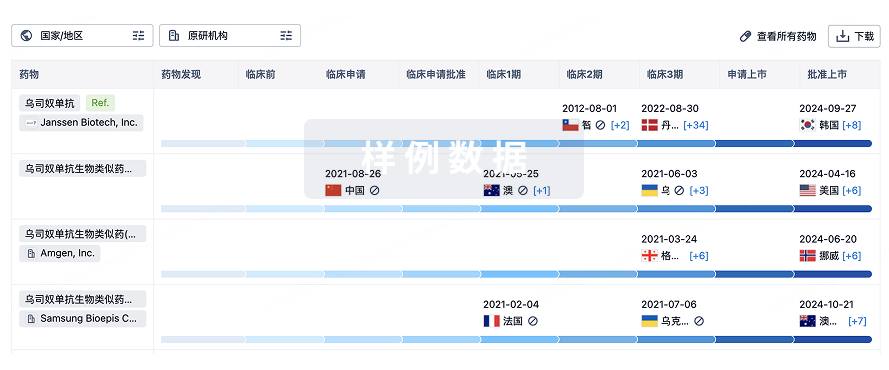预约演示
更新于:2025-12-27
Semaglutide(Hybio)
司美格鲁肽(深圳翰宇)
更新于:2025-12-27
概要
基本信息
原研机构 |
在研机构 |
非在研机构- |
最高研发阶段临床3期 |
首次获批日期- |
最高研发阶段(中国)临床3期 |
特殊审评- |
登录后查看时间轴
关联
4
项与 司美格鲁肽(深圳翰宇) 相关的临床试验CTR20243301
一项在肥胖患者中比较HY310注射液与诺和盈®治疗44周的疗效和安全性的多中心、随机、开放设计的Ⅲ期临床研究
主要目的:以原研司美格鲁肽注射液(诺和盈®)为对照,评价深圳翰宇药业股份有限公司生产的司美格鲁肽注射液(HY310注射液)辅助生活方式干预治疗肥胖患者的有效性。
次要目的:1.以原研司美格鲁肽注射液(诺和盈®)为对照,评价HY310注射液对腰围和体重指数(BMI)的影响;2.评价HY310注射液在肥胖患者中的安全性;3.评价HY310注射液在肥胖患者中的免疫原性。
开始日期2025-01-02 |
申办/合作机构 |
CTR20243084
一项在二甲双胍单药治疗血糖控制不佳的2型糖尿病患者中比较HY310注射液与诺和泰®治疗32周的疗效和安全性的多中心、随机、开放设计的Ⅲ期临床研究
主要目的:以诺和泰为对照药,评估深圳翰宇药业股份有限公司提供的司美格鲁肽注射液(HY310)在二甲双胍单药治疗血糖控制不佳的2型糖尿病患者中的有效性。
次要目的:1.以诺和泰为对照药,评估HY310注射液在二甲双胍单药治疗血糖控制不佳的2型糖尿病患者中的安全性。2.评价HY310注射液在2型糖尿病患者中的免疫原性。3.评价HY310注射液在2型糖尿病患者中的群体药代动力学特征。
开始日期2024-08-24 |
申办/合作机构 |
ACTRN12623001277639
Evaluating the efficacy of REducing cardiometabolic risk with SEmaglutide by measuring arterial stiffness in overweight and obese adults aged over 25 with Type 1 diabetes
开始日期2024-03-12 |
100 项与 司美格鲁肽(深圳翰宇) 相关的临床结果
登录后查看更多信息
100 项与 司美格鲁肽(深圳翰宇) 相关的转化医学
登录后查看更多信息
100 项与 司美格鲁肽(深圳翰宇) 相关的专利(医药)
登录后查看更多信息
21
项与 司美格鲁肽(深圳翰宇) 相关的文献(医药)2026-03-01·NUTRITION
The impact of nutrition, exercise, and pharmacotherapy on menstrual health in adolescents with overweight and obesity
Review
作者: Jacobson-Dickman, Elka ; Wu, Julius
BACKGROUND:
Menstrual health is a critical marker of physiological and psychological well-being in adolescents. While undernutrition and energy deficiency are well-known causes of menstrual disruption through hypothalamic hypogonadal suppression, the impact of overweight and obesity on menstrual physiology is an increasing clinical concern as adolescent obesity rates continue to rise globally.
OBJECTIVES:
This review synthesizes current evidence on how excess adiposity, diet quality, physical activity, insulin sensitizers, and weight-modifying medications affect menstrual health in adolescents through the complex interplay of metabolic fuel signaling and reproductive endocrine pathways.
METHODS:
We review the activity of the hypothalamic-pituitary-gonadal axis during pubertal development and the reproductive years, highlighting how metabolic signals, particularly leptin, insulin, and ghrelin, influence gonadotropin-releasing hormone secretion. We explore how excess adiposity may accelerate menarche, disrupt menstrual regularity, and increase the risk of polycystic ovary syndrome and hyperandrogenism, likely through hyperinsulinemia and altered gonadotropin-releasing hormone pulsatility. We also discuss the contributions of suboptimal diet quality and obesity to chronic inflammation and ovarian dysfunction.
RESULTS:
Structured lifestyle interventions, including dietary modifications and regular physical activity, remain the cornerstone of managing overweight-related menstrual irregularities, to restore cycle regularity, and improve features of polycystic ovary syndrome. Insulin sensitizers, such as metformin, offer additional benefits for both metabolic and reproductive dysfunction. Newer incretin-based therapies, including semaglutide and tirzepatide, show promise in achieving significant weight reduction and metabolic improvements, with potential downstream benefits for menstrual health. However, data on their safety, reproductive outcomes, and optimal use in adolescents remain limited, and this area of research is still emerging.
CONCLUSIONS:
While underweight status and malnutrition are important underpinnings of functional hypothalamic amenorrhea, the rising prevalence of overweight and obesity poses a growing risk to menstrual health in adolescents. Early, comprehensive, and personalized strategies that integrate nutrition, physical activity, psychological support, and, when appropriate, insulin sensitizers and other pharmacotherapies can help protect and enhance reproductive endocrine function, preserve fertility, and mitigate long-term health risks. Further research is needed to clarify the impact and long-term effects of novel weight-loss medications in order to inform clinical practice in adolescent care.
2026-02-01·EUROPEAN JOURNAL OF PHARMACEUTICAL SCIENCES
Single-dose pharmacokinetics of sublingual semaglutide in rats
Article
作者: Banov, Daniel ; Denison, Jennifer ; Davis, Courtaney ; Ip, Kendice ; Liu, Yi ; Song, Guiyun
This study aims to compare the single-dose pharmacokinetic profiles of semaglutide administered via sublingual, oral, and injectable routes in Sprague-Dawley rats. Semaglutide was delivered sublingually in a proprietary anhydrous suspension vehicle. Rats were randomized into five groups and received the following treatments: subcutaneous injection (0.011 mg/kg), sublingual suspension (1 mg/kg, prepared from either commercial tablets or peptide powder), and oral tablets (1 mg/kg and 20 mg/kg). Semaglutide was detectable in plasma within 2 minutes post-dosing in all groups except the oral 1 mg/kg group. Sublingual administration demonstrated lower variability in plasma concentrations compared to oral dosing. At 1 mg/kg, the sublingual route achieved a significantly higher area under the curve (AUC) than oral (82.53 vs.15.08 ng*h/ml, p=0.004), indicating improved bioavailability. The maximum plasma concentration (Cmax) was reached within 30 minutes for oral and sublingual routes, and at 8 hours for subcutaneous injection. The relative bioavailability was 0.06% for oral 1 mg/kg, 0.16% for oral 20 mg/kg, and 0.34% and 0.29% for sublingual 1 mg/kg using tablets or powder, respectively. No significant difference in AUC was observed between sublingual semaglutide prepared from oral tablets versus powder. These results highlight the potential of sublingual delivery of semaglutide and suggest this route may improve absorption while reducing variability. This proof-of-concept study supports further development of sublingual semaglutide formulations and pharmacokinetics research in humans.
2026-01-01·EUROPEAN JOURNAL OF PHARMACOLOGY
GLP-1RA partially alleviates obesity-induced reproductive dysfunction driven by the interplay mechanisms of inflammation and metabolic dysregulation via the SIRT-associated pathway
Article
作者: Lin, Zhongliang ; Zhu, Kejing ; Hefeng, Huang ; Matiki, Tashinga Walter ; Sheng, Jianzhong ; Yin, Lin ; Ul Haq Shah, Mohd Zahoor ; Liu, Rui
Obesity-induced reproductive dysfunction is driven by chronic low-grade inflammation and metabolic dysregulation. The potential modulatory effect of GLP-1RAs on the interplay mechanisms of inflammation and metabolic dysregulation in obesity-induced reproductive dysfunction remains unclear. Hence, we investigated the effect of semaglutide on reproductive function via the SIRT-associated pathway in obese female mice. Female mice were divided into three groups: control-normal diet (NC), obesity-high fat diet (HFD), and intervention-high fat diet + semaglutide (HS). Mice body weight, composition and metabolic response to glucose, insulin, and pyruvate were evaluated. Systemic and ovarian inflammatory cytokines (IL-1β, NF-κB, IL-6, TNF-α), reproductive hormones (P4, E2, FSH, LH), and ovarian expression of SIRT1, SIRT6, FOXO1, FOXO3a, NRF1, IRS1, iNOS, eNOS, p27 KIP1, and PTEN were evaluated. The ovarian tissues were analyzed for structural changes, lipid accumulation, oxidative stress, and follicular development. Oocyte's mitochondrial function, DNA damage, lipid and ROS levels, and fertility tests were assessed. Adiposity and metabolic dysregulation, mainly insulin resistance and IRS1 disruption, were observed in the obese group. The HFD group showed higher NF-κB-associated pro-inflammatory cytokine expressions, oxidative stress, FOXO1 and iNOS expression, reduced SIRT1, SIRT6, FOXO3a, NRF1, eNOS levels, and dysregulated p27 KIP1/PTEN colocalization. These observed changes were accompanied by reduced P4 and E2, elevated FSH and LH, disrupted ovarian morphology, ovarian and oocyte lipid accumulation, oocyte DNA damage, and reduced fertility outcomes in the HFD group. Semaglutide treatment alleviated the dysfunctions observed in the obese group. Our findings demonstrated that GLP-1RAs (semaglutide) have potential therapeutic effects on obesity-induced reproductive dysfunctions by modulating the interplay mechanisms of inflammation and metabolic dysregulation via the SIRT-associated pathway.
118
项与 司美格鲁肽(深圳翰宇) 相关的新闻(医药)2025-12-25
·今日头条
中国GLP-1药物迎来突破性进展 降糖减重赛道概念股迎发展机遇
代谢疾病治疗领域再添中国创新力量,一款新型降糖减重药物的两项Ⅲ期临床研究成果展现出优异疗效,在血糖控制、减重效果上显著优于传统药物,同时可改善心血管、肝脏及肾脏相关指标,为全球糖尿病合并肥胖等代谢疾病提供了全新治疗方案。这一突破不仅填补了国内相关领域的技术空白,更推动GLP-1受体激动剂赛道进入加速发展期,A股产业链相关概念股有望充分受益于行业扩容。
核心研发企业:A股布局GLP-1赛道的标杆玩家
1. 华东医药:全方位布局GLP-1赛道,商业化与研发双线领跑
公司在GLP-1领域构建了覆盖创新药、生物类似药的全方位产品管线,已上市国内首个利拉鲁肽生物类似药,获批用于2型糖尿病治疗及体重管理。其司美格鲁肽注射液的上市申请已获受理,用于2型糖尿病患者血糖控制,体重管理适应症Ⅲ期临床试验已完成首例受试者入组。在研管线中,口服小分子GLP-1受体激动剂HDM1002正在推进糖尿病适应症Ⅱ期及体重管理适应症Ⅲ期研究,双靶点激动剂HDM1005已在多个适应症上获得国内外临床试验批准,三靶点激动剂DR10624也已启动Ⅱ期临床,形成从单靶点到多靶点、从注射剂到口服剂型的完整布局。
2. 恒瑞医药:口服GLP-1药物突破,给药便利性升级
公司自主研发的新型口服小分子GLP-1受体激动剂HRS-7535展现出显著潜力,在Ⅱ期临床研究中,针对二甲双胍控制不佳的2型糖尿病患者,各剂量组糖化血红蛋白降幅显著优于安慰剂,最高剂量组体重较基线降低2.63%;在肥胖人群研究中,180mg剂量组治疗36周平均体重降低达9.47%,41.7%的患者体重降幅超10%。该药物采用口服给药方式,有望解决传统注射剂的依从性痛点,目前治疗2型糖尿病及肥胖的Ⅲ期临床研究正在推进中,为代谢疾病治疗提供更便捷的选择。
3. 众生药业:双靶点药物推进Ⅲ期,拓展多适应症布局
公司控股子公司研发的RAY1225注射液是具有全球自主知识产权的GLP-1/GIP双靶点激动剂,具备每两周注射一次的长效优势。该药物用于肥胖/超重患者的Ⅲ期临床试验正在推进,近日新增代谢相关脂肪性肝炎适应症的临床试验获批。临床前研究显示,其可改善肝脏炎症、纤维化等指标,降低体重及肝脏脂肪水平,有望成为覆盖降糖、减重、肝脏代谢疾病的多功能药物。
4. 翰宇药业:多肽药物龙头,深度布局降糖减重领域
作为国内多肽药物研发生产龙头企业,公司在GLP-1受体激动剂领域拥有深厚技术积淀,通过自主研发与合作布局相结合,聚焦降糖减重药物的创新开发。依托成熟的多肽合成与制剂技术平台,公司在长效、高选择性GLP-1类药物研发上持续突破,相关产品有望受益于赛道需求的快速增长。
产业链配套企业:受益于赛道扩容的核心支撑力量
GLP-1类药物的研发生产涉及多肽合成、制剂工艺、临床服务等多个环节,产业链上下游企业将同步分享行业发展红利:
- CDMO/CMO龙头:凯莱英、药明康德、九洲药业等企业具备成熟的多肽药物合成与生产能力,可为GLP-1类药物研发企业提供从临床前到商业化的全流程服务,随着相关药物进入临床后期及上市阶段,订单需求有望持续释放。
- 原料药及辅料企业:山河药辅、尔康制药等企业为降糖减重药物提供专用辅料及相关原料,在制剂稳定性、生物利用度提升方面发挥关键作用,受益于终端药物的产能扩张。
行业前景:千亿蓝海市场加速成型
全球代谢疾病治疗市场需求旺盛,我国成年糖尿病患者人数超1.48亿,其中未治疗率达52.7%,同时肥胖人群规模持续扩大,降糖减重药物存在巨大的未被满足需求。GLP-1受体激动剂凭借降糖、减重、心血管保护的多重功效,已成为代谢疾病治疗的主流方向,全球市场规模已超千亿元人民币。
随着国内企业在该领域的技术突破与产品上市,国产GLP-1类药物有望凭借性价比优势实现进口替代,同时在多靶点药物、口服剂型、新适应症拓展等方面形成差异化竞争。政策层面,国家对创新药的支持力度持续加大,加速了临床审批与上市进程,为赛道发展提供良好环境。未来,随着更多国产药物获批及医保准入,GLP-1赛道将迎来高速增长期,产业链相关企业有望持续受益,但需警惕临床研发不及预期、市场竞争加剧等潜在风险。
免责声明
1. 本报告所涉及信息均来源于公开可获取资料,力求准确可靠,但不对信息的准确性、完整性和及时性作出任何保证,据此投资需自行承担风险。
2. 本报告仅为行业研究与参考,不构成任何投资建议、投资引导或交易承诺。投资者应结合自身风险承受能力,独立判断并决策。
3. 股市有风险,投资需谨慎。市场波动受宏观经济、行业周期、政策变化等多重因素影响,过往业绩不代表未来表现,请勿盲目跟风投资。
临床3期生物类似药临床2期临床1期
2025-12-24
·贝塔调研
1、公司创新药研发管线的布局。
答:公司立足自主研发,整合内外部资源,以满足未被满足的临床需求为目标,前瞻性地开展相关创新药的研究。公司创新药研发主要聚焦代谢性疾病、呼吸系统疾病等领域,截至目前,已有 2 个创新药项目获批上市,多个创新药项目处于临床试验阶段,并探索布局具备差异化优势的早研管线。
(1)代谢性疾病研发管线
ZSP1601 片是具有全新作用机制的治疗代谢功能障碍相关脂肪性肝炎(MASH)的一类创新药,为国家重大新药创制项目,也是首个完成健康人药代及安全性临床试验的用于治疗 MASH 的国内创新药项目。目前已完成的 Ib/IIa 期临床试验结果表明,在 4 周的治疗下,ZSP1601 片明显地降低了 ALT、AST 等肝脏炎症损伤标志物,同时多个纤维化相关生物标志物也有降低趋势,提示其具有改善肝脏炎症、坏死的潜力及抗纤维化的作用,研究结果已发表在自然杂志子刊《NatureCommunications》。该项目正在开展 IIb 期临床试验,参与者入组工作已于 2024 年内完成,研究正在进行中。
RAY1225 注射液是具有全球自主知识产权的创新结构多肽药物,具有 GLP-1 受体和 GIP 受体双重激动活性,得益于优异的药代动力学特性,具备每两周注射一次的超长效药物潜力,临床上拟用于 2 型糖尿病及肥胖/超重等患者的治疗。目前,公司正在推进 RAY1225 注射液治疗中国肥胖/超重患者的安全性和有效性 III 期临床试验(REBUILDING-2 研究)、RAY1225 注射液单药治疗 2 型糖尿病患者的安全性和有效性、安慰剂对照 III 期临床试验(SHINING-2)和 RAY1225 注射液与口服降糖药物联合治疗 2 型糖尿病患者的安全性和有效性、司美格鲁肽注射液对照的 III 期临床试验(SHINING-3)。
(2)呼吸系统疾病研发管线
来瑞特韦片(商品名:乐睿灵®)是中国首款具有自主知识产权的 3CL 单药口服抗新冠病毒感染的一类创新药物,无需联用利托那韦作为增效剂,凭借优秀的安全性及显著的疗效,尤其适用于老年人及合并基础疾病的患者,并且轻中度肝功能不全人群和轻中重肾功能不全患者在治疗期间服用来瑞特韦片不需要调整剂量。昂拉地韦片(商品名:安睿威®)是全球首个靶向流感病毒 RNA 聚合酶 PB2 亚基的一类创新药物,于 2025 年 5 月获批上市,对奥司他韦、玛巴洛沙韦耐药病毒株保持强效抑制作用,为患者提供更优治疗选择,并且为破解流感用药耐药困局提供了结构性优势,已经谈判成功纳入2025 年版《国家医保目录》。安睿威® II 期临床试验结果发表在柳叶刀杂志子刊《The Lancet Infectious Diseases》,III 期临床试验结果发表在呼吸与危重症医学领域国际顶级科技期刊、柳叶刀杂志子刊《The Lancet Respiratory Medicine》。
目前,公司正在推进昂拉地韦颗粒治疗 2~11 岁儿童单纯性甲型流感患者和昂拉地韦片治疗 12~17 岁青少年单纯性甲型流感患者的两项 III 期临床试验。
(3)备具差异化优势的早研管线
公司结合小分子、多肽药物等新药研发技术平台优势,在呼吸系统、代谢性疾病领域布局备具差异化优势的早研管线。
在呼吸系统疾病领域,公司挖掘未被满足的临床需求,布局了用于治疗呼吸道合胞病毒(RSV)感染的化学小分子创新药项目,其对多种 RSV 病毒株的体内外抗病毒活性强、药代特性优秀、化合物毒性低。目前国内尚无针对 RSV 的特异性治疗药物,该项目未来有望满足临床需求。公司已确定该项目的临床前候选化合物(PCC),正在开展临床前研究工作。
在代谢性疾病领域,GLP-1RA 类及减重相关的研发思路逐渐进入多靶点协同、超长效制剂、口服化制剂、多系统获益的新时代。公司始终密切关注代谢领域的前沿技术和潜在靶点,积极探索 Amylin 类多肽皮下注射药物、多肽类口服药物、GLP-1RA 类小分子口服药物、Amylin 类小分子口服药物在内的各类潜力赛道。上述项目在分子优化、确定 PCC 以及动物试验等不同阶段,进一步丰富公司创新药研发管线,为广大患者提供更多治疗选择。
2、公司新药进入新版医药目录情况。
答:2025 年 12 月 7 日,根据国家医保局、人力资源社会保障部发布的《关于印发<国家基本医疗保险、生育保险和工伤保险药品目录>以及<商业健康保险创新药品目录>(2025年)的通知》(医保发〔2025〕33 号),公司一类创新药物昂拉地韦片(商品名:安睿威®)通过国家医保谈判,首次被纳入《国家基本医疗保险、生育保险和工伤保险药品目录(2025 年)》(以下简称“2025 年版《国家医保目录》”)。同时,公司核心产品来瑞特韦片、复方血栓通胶囊、脑栓通胶囊、硫糖铝口服混悬液、羧甲司坦口服溶液、盐酸氮䓬斯汀滴眼液等继续入选 2025 年版《国家医保目录》。
昂拉地韦片(商品名:安睿威®)是全球首款靶向甲型流感病毒 RNA 聚合酶 PB2 亚基的一类创新药,适用于成人单纯性甲型流感患者的治疗,具有快速、强效、低耐药等特点,能够快速缓解全身流感症状、强效抗击流感病毒,兼具低耐药性,于 2025 年 5 月获国家药监局批准上市。昂拉地韦片是公司呼吸管线的创新药重要产品,本次成功纳入 2025 年版《国家医保目录》乙类范围,有望惠及更多患者,为患者提供经济、安全、可及的用药选择。
3、昂拉地韦针对儿童及青少年适应症临床研发情况。
答:公司为方便儿童、青少年及吞咽困难的流感患者用药,开发的甲型流感一类创新药物昂拉地韦颗粒。目前已获得II 期临床试验顶线分析数据,昂拉地韦颗粒在临床症状/体征和病毒学方面均取得了积极的有效性结果,且具有良好的安全性和耐受性。
公司组织昂拉地韦片治疗12~17岁青少年单纯性甲型流感患者和昂拉地韦颗粒治疗2~11岁儿童单纯性甲型流感患者的两项III期临床试验,目前已完成所有参与者入组。上述两项关键III期研究双线完成入组的突破,标志着公司在构建覆盖成人、青少年、儿童全年龄段流感防治矩阵的道路上取得了决定性进展。公司将继续按照相关要求高质量、加速度、科学规范地推进上述两项III期临床试验。
4、RAY1225注射液临床试验的情况。
答:RAY1225注射液是具有全球自主知识产权的创新结构多肽药物,具有GLP-1受体和GIP受体双重激动活性,得益于优异的药代动力学特性,具备每两周注射一次的超长效药物潜力,临床上拟用于2型糖尿病及肥胖/超重等患者的治疗。
RAY1225注射液在治疗中国肥胖/超重患者(REBUILDING-1研究)与2型糖尿病患者(SHINING-1研究)的两项II期临床试验已获得3~9mg试验组的顶线分析数据结果,达到主要终点,RAY1225注射液表现出积极的疗效和优秀的安全性,胃肠道相关不良反应和低血糖风险的发生率均低于替尔泊肽SURMOUNT-CN和SURPASS-AP-Combo的报道数据。以上两项II期临床试验获邀在第84届美国糖尿病学年会(ADA)以壁报形式进行汇报,RAY1225注射液优秀的有效性和安全性数据获得国内外专业人士的广泛关注。
目前,RAY1225注射液用于治疗中国肥胖/超重患者的安全性和有效性III期临床试验(REBUILDING-2研究)已顺利启动并完成全部参与者入组工作;RAY1225注射液单药治疗2型糖尿病患者的安全性和有效性、安慰剂对照III期临床试验(SHINING-2)和RAY1225注射液与口服降糖药物联合治疗2型糖尿病患者的安全性和有效性、司美格鲁肽注射液对照的III期临床试验(SHINING-3)两项降糖III期临床试验目前参与者入组情况顺利。2025年12月,RAY1225注射液新增适应症治疗“代谢相关脂肪性肝炎”的药物临床试验获得国家药品监督管理局批准,并收到《药物临床试验批准通知书》,同意RAY1225注射液新增适应症进行临床试验。
响应国家“体重管理年”的号召,公司坚守创新研发核心,将高质量、加速度、科学规范推进临床试验。公司聚焦代谢性疾病、呼吸系统疾病等领域,深耕安全健康减重相关创新药研发,以严谨标准突破技术壁垒,加快项目落地。
5、RAY1225 注射液新增适应症的情况。
答:代谢相关脂肪性肝炎(MASH)是由过量脂肪细胞引起的肝脏炎症,可导致进行性肝纤维化和肝硬化。MASH 的患者基数相当庞大,目前国内尚无专门获批用于治疗 MASH 的药物,存在巨大的未被满足的临床治疗需求,因此开发有效的 MASH治疗药物对改善患者的健康状况至关重要。
RAY1225 能选择性结合并激活 GLP-1 受体和 GIP 受体,以葡萄糖依赖的方式促进胰岛素分泌和抑制胰高血糖素从而控制血糖,同时抑制胃排空,抑制食欲,降低体重,降低外周胰岛素抵抗,改善肝脏脂肪变性和气球样变等。RAY1225 的临床前研究结果表明,在 MASH 动物模型中 RAY1225 可改善的 NAS评分(评估肝脏炎症、坏死、纤维化等)、降低体重、改善脏体系数、糖脂代谢和肝脏脂肪水平,并呈现剂量相关性,临床上有望用于 MASH 的治疗。公司将结合实际情况,有序推进创新药研发项目。
临床3期临床2期上市批准申请上市临床成功
2025-12-19
·有驾
近期,多家中国领先医药企业陆续交出亮眼“成绩单”,在创新药出海、国际授权合作及海外市场准入等方面取得系列突破性进展,显示中国医药研发实力正获得全球市场广泛认可,行业景气度显著回升。
CXO龙头业绩倍增,海外需求强劲复苏
药明康德作为全球医药研发外包服务(CXO)领域的龙头企业,2024年上半年净利润实现同比翻倍增长,增长势头强劲。业绩大幅提升的背后,是来自北美及欧洲等地区大型制药客户的订单持续放量,反映出国际医药研发产业链对中国高端研发服务能力的依赖与信心日益巩固。
多肽药物成功闯关,翰宇药业全球布局提速
翰宇药业凭借其在多肽药物领域的深耕,成功抓住全球GLP-1类减肥降糖药物的市场风口。其核心产品利拉鲁肽注射液已正式获得美国FDA批准上市,另一重磅产品司美格鲁肽注射液也已顺利完成关键临床试验。两大产品的进展标志着公司国际化战略迈出实质性步伐,为其参与全球百亿美元级市场竞争奠定基础。
创新药获FDA快速认可,迪哲医药彰显研发硬实力
迪哲医药的原创肺癌靶向药物舒沃替尼,在美获批用于治疗特定EGFR突变非小细胞肺癌。尤为引人注目的是,该药上市申请获美国FDA一次性直接批准,未要求补充任何额外数据,审批流程极为顺畅。这一案例不仅证明了药物自身的优异临床数据,也凸显了中国创新药企的研发质量已能够满足国际最高监管标准。
携手国际巨头,康方生物技术平台价值凸显
康方生物以其领先的双特异性抗体及ADC(抗体偶联药物)技术平台,成功吸引了全球制药巨头辉瑞的关注。双方达成的合作协议总金额高达60亿美元,同时,基于合作的一款创新药物已顺利进入临床病人试验阶段。与辉瑞的深度绑定,是对康方生物技术平台创新实力和市场潜力的重磅背书。
行业拐点已现,静待价值重估
除上述企业外,近期行业内多家公司频传海外授权捷报,单笔交易金额屡创新高,ADC等前沿技术领域更是成为国际药企争相合作的焦点。综合来看,中国医药行业正从过去数年的调整中逐步走出,驱动力已从国内政策导向,扩展至全球市场验证与商业兑现。创新药出海成功案例的不断积累,不仅为企业自身打开了长期成长空间,也预示着整个板块有望迎来基本面和估值层面的双重修复。
尽管资本市场短期波动难免,但以扎实的临床数据、成功的国际审批和重磅的海外合作为代表的实质性进展,正为行业注入确定性更强的增长动力。当沉寂的领域开始接连传出突破性消息,往往预示着新的产业趋势正在形成。中国医药行业的“国际化春天”,或许已在悄然来临的路上。
100 项与 司美格鲁肽(深圳翰宇) 相关的药物交易
登录后查看更多信息
外链
| KEGG | Wiki | ATC | Drug Bank |
|---|---|---|---|
| - | - | - |
研发状态
10 条进展最快的记录, 后查看更多信息
登录
| 适应症 | 最高研发状态 | 国家/地区 | 公司 | 日期 |
|---|---|---|---|---|
| 肥胖 | 临床3期 | 中国 | 2025-01-02 | |
| 2型糖尿病 | 临床3期 | 中国 | 2024-08-24 |
登录后查看更多信息
临床结果
临床结果
适应症
分期
评价
查看全部结果
| 研究 | 分期 | 人群特征 | 评价人数 | 分组 | 结果 | 评价 | 发布日期 |
|---|
No Data | |||||||
登录后查看更多信息
转化医学
使用我们的转化医学数据加速您的研究。
登录
或

药物交易
使用我们的药物交易数据加速您的研究。
登录
或

核心专利
使用我们的核心专利数据促进您的研究。
登录
或

临床分析
紧跟全球注册中心的最新临床试验。
登录
或

批准
利用最新的监管批准信息加速您的研究。
登录
或

生物类似药
生物类似药在不同国家/地区的竞争态势。请注意临床1/2期并入临床2期,临床2/3期并入临床3期
登录
或

特殊审评
只需点击几下即可了解关键药物信息。
登录
或

生物医药百科问答
全新生物医药AI Agent 覆盖科研全链路,让突破性发现快人一步
立即开始免费试用!
智慧芽新药情报库是智慧芽专为生命科学人士构建的基于AI的创新药情报平台,助您全方位提升您的研发与决策效率。
立即开始数据试用!
智慧芽新药库数据也通过智慧芽数据服务平台,以API或者数据包形式对外开放,助您更加充分利用智慧芽新药情报信息。
生物序列数据库
生物药研发创新
免费使用
化学结构数据库
小分子化药研发创新
免费使用



